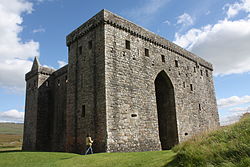Hermitage Castle
| Hermitage Castle | |
|---|---|
| Near Newcastleton, Roxburghshire, Scotland GB grid reference NY495960 |
|

Hermitage Castle
|
|
| Type | First phase: motte and bailey Second phase: tower house/keep with barmkin |
| Site information | |
| Owner | Historic Scotland |
| Open to the public |
Yes |
| Condition | Partially ruined |
| Site history | |
| Built | First phase: c.1240 Second phase: mid 14th century |
| Built by | First phase: Nicholas de Soulis Second phase: William Douglas, 1st Earl of Douglas |
| In use | Until 1705 |
| Materials | First phase: timber Second phase: stone |
Hermitage Castle is a semi-ruined castle in the border region of Scotland. It is under the care of Historic Scotland. The castle has a reputation, both from its history and its appearance, as one of the most sinister and atmospheric in Scotland.
It is thought that the name derives from Old French: l'armitage – guardhouse. The castle was known as the guardhouse of the bloodiest valley in Britain, and the "Strength of Liddesdale".
Hermitage Castle was supposedly built by one Nicholas de Soulis around 1240, in a typical Norman Motte and Bailey pattern. It stayed in his family until approximately 1320, when his descendant, William de Soulis forfeited it because of suspected witchcraft and the attempted regicide of King Robert I of Scotland. Legend has it that Soulis' tenantry, having suffered unbearable depredations, arrested him, and at the nearby Ninestane Rig (a megalithic circle), had him boiled to death in molten lead. In actuality, he died, a prisoner, in Dumbarton Castle. Hermitage Castle is reputed to be haunted by Redcap Sly, de Soulis's familiar spirit.
In 1338, the then incumbent, Englishman Sir Ralph de Neville was besieged by Sir William Douglas, The Knight of Liddesdale, known as the "Flower of Chivalry" (this sobriquet had to do with his abilities as a knight, although it is often misinterpreted by people with a rather romantic view of history). It was here that Douglas imprisoned, and had starved to death, his erstwhile comrade Sir Alexander Ramsay of Dalhousie. Upon Douglas's death, brought about by near kinsman and namesake, William Douglas, 1st Earl of Douglas, the Castle fell into the hands of the Dacre family for a time. It soon fell back into the hands of Earl William through inheritance, and it was he that enabled the construction of most of the present building, possibly with the help of John Lewin, master mason at Durham Cathedral. The Earl's sons provided the seed of the two famous branches of the house – the 'Black' (for Earls of Douglas) and 'Red' (for the Earls of Angus). By 1455 the Black line had so incensed the King that James Douglas, 9th Earl of Douglas was forfeited, never to return, and the beneficences that they had enjoyed passed to the 'Red' line of Angus, including Hermitage Castle.
...
Wikipedia
